
Marble Madness is an arcade video game designed by Mark Cerny and published by Atari Games in 1984. It is a platform game in which the player must guide a marble through six courses, populated with obstacles and enemies, within a time limit. The player controls the marble by using a trackball. Marble Madness is known for using innovative game technologies: it was Atari's first to use the Atari System 1 hardware, the first to be programmed in the C programming language, and one of the first to use true stereo sound.
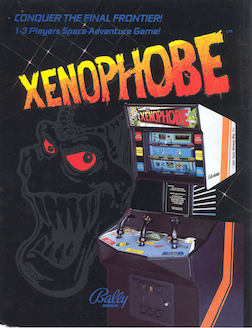
Xenophobe is a video game developed by Bally Midway and released in arcades in 1987. Starbases, moons, ships, and space cities are infested with aliens, and the players have to kill the aliens before each is completely overrun. The screen is split into three horizontally-scrolling windows, one for each of up to three players, yet all players are in the same game world.

Centipede is a 1981 fixed shooter arcade video game developed and published by Atari, Inc. Designed by Dona Bailey and Ed Logg, it was one of the most commercially successful games from the golden age of arcade video games and one of the first with a significant female player base. The primary objective is to shoot all the segments of a centipede that winds down the playing field. An arcade sequel, Millipede, followed in 1982.

A beer tap is a valve, specifically a tap, for controlling the release of beer. While other kinds of tap may be called faucet, valve or spigot, the use of tap for beer is almost universal. The word was originally coined for the wooden valve in traditional barrels. Beer served from a tap is largely known as draught beer, though beer served from a cask is more commonly called cask ale, while beer from a keg may specifically be called keg beer. Beer taps can be also used to serve similar drinks like cider or long drinks.

Klax is a puzzle video game released in arcades in 1990 by Atari Games while Namco distributed the game in Japanese markets. It was designed and animated by Mark Stephen Pierce with the software engineering done by Dave Akers. The object is to catch colored blocks tumbling down a machine and arrange them in colored rows and patterns to make them disappear. Klax was originally published as a coin-op follow-up to Tetris, about which Atari Games was in a legal dispute at the time.

Super Sprint is a racing video game released by Atari Games and Midway Games in 1986. Up to three players drive Formula One-like cars on a circuit that is viewed from above. The game is a successor to Gran Trak 10 and the Sprint series, which were black-and-white games from the 1970s. A sequel, Championship Sprint, was released later in the same year.

Paperboy is an arcade action game developed and published by Atari Games, and released in 1985. The player takes the role of a paperboy who delivers a fictional newspaper called The Daily Sun along a street on his bicycle. The arcade version of the game featured bike handlebars as the controller.

Rampage is a 1986 arcade video game by Bally Midway. Inspired by monster films, players control a trio of monsters: George, Lizzie, and Ralph, humans turned into creatures due to various experimental mishaps. The objective is to destroy cities and combat military forces while maintaining their health. The game is set across 128 days in cities across North America, with each cycle repeating five times. Gameplay includes destroying buildings, eating humans, and avoiding damage.

Midway Arcade Treasures is a video-game compilation of 24 arcade games, emulated from the original PCBs. The overall release was developed by Digital Eclipse and issued by Midway for the PlayStation 2, Xbox, GameCube, and Microsoft Windows.

A keg is a small cask.
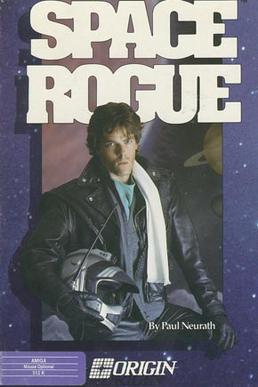
Space Rogue is a space flight simulation video game developed by Origin Systems and published by Origin Systems, Wave Brain, and Night Dive Studios. The game was released in 1989 for Apple II and Commodore 64; the series was later ported to DOS, Macintosh, Amiga, and Atari ST. The game was also released in the Japanese language for PC-9801, X68000, and FM Towns. The FM Towns version had its intro remade with slight animations and new illustrations, along with scrolling Japanese text, and exclusive CD quality background music. Taking place within the Far Arm of the Milky Way galaxy, Space Rogue's main story revolves around the player character's efforts to pursue a career and undertake long-range goals beyond his immediate mission.

Kegerator, a portmanteau of the words keg and refrigerator, is a refrigerator that has been designed or altered to store and dispense kegs.
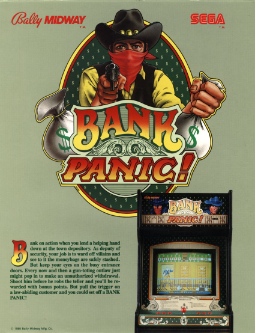
Bank Panic is an arcade shooter game developed by Sanritsu Denki and released by Sega in 1984. Bally-Midway manufactured the game in the US. The player assumes the part of an Old West sheriff who must protect a bank and its customers from masked robbers.

Wizard of Wor is an arcade video game released in 1981 by Midway. Up to two players fight together in a series of monster-infested mazes, clearing each maze by shooting the creatures. The game was ported to the Atari 8-bit computers, Commodore 64, Atari 2600, and Atari 5200 and renamed to The Incredible Wizard for the Bally Astrocade. The original cartridge came with a cash prize offer to the first person to complete the game.
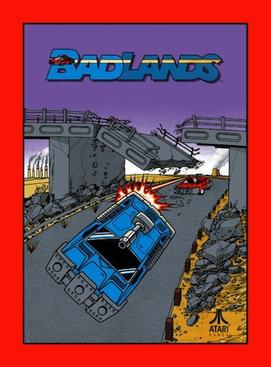
Badlands is a 1989 arcade video game published by Atari Games. It was ported by Domark under the Tengen label to the Amiga, Amstrad CPC, Atari ST, Commodore 64, and ZX Spectrum. The game is a re-themed version of Atari's previous racing games Super Sprint and Championship Sprint with the addition of vehicular combat. Badlands is set in the aftermath of a nuclear war and races around abandoned wastelands with many hazards. Three gun-equipped cars race around a track to win prizes.

Xybots is a 1987 third-person shooter arcade game by Atari Games. In Xybots, up to two players control "Major Rock Hardy" and "Captain Ace Gunn", who must travel through a 3D maze and fight against a series of robots known as the Xybots whose mission is to destroy all mankind. The game features a split screen display showing the gameplay on the bottom half of the screen and information on player status and the current level on the top half. Designed by Ed Logg, it was originally conceived as a sequel to his previous title, Gauntlet. The game was well received, with reviewers lauding the game's various features, particularly the cooperative multiplayer aspect. Despite this, it was met with limited financial success, which has been attributed to its unique control scheme that involves rotating the joystick to turn the player character.
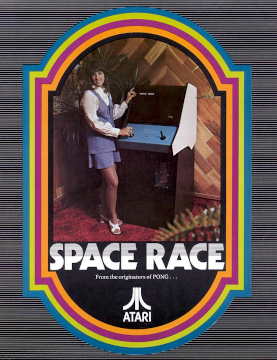
Space Race is an arcade game developed by Atari, Inc. and released on July 16, 1973. It was the second game by the company, after Pong (1972), which marked the beginning of the commercial video game industry along with the Magnavox Odyssey. In the game, two players each control a rocket ship, with the goal of being the first to move their ship from the bottom of the screen to the top. Along the way are asteroids, which the players must avoid. Space Race was the first racing arcade video game and the first game with a goal of crossing the screen while avoiding obstacles.

Timber is an arcade game manufactured by Bally Midway in 1984. The goal is to amass points by chopping down trees, then logrolling in bonus rounds. Two players can compete simultaneously in the same play area. Timber was designed by Steve Meyer, who also designed Tapper, and both games have a similar audio/visual style.

Gridrunner is a fixed shooter video game written by Jeff Minter and published by Llamasoft for the VIC-20 in 1982. It was ported to the Atari 8-bit computers, ZX Spectrum, Commodore 64, Commodore PET and Dragon 32. Many remakes and sequels have followed, including versions for the Atari ST, Amiga, Pocket PC, Microsoft Windows, and iOS.

Tapper World Tour is a reinterpretation of the 1983 Bally Midway arcade game Tapper for iOS. Players take the role of a bartender with the goal of serving drinks and collecting empty glasses and tips from a demanding group of patrons. The game was developed by Square One Studios and published by WB Games.























